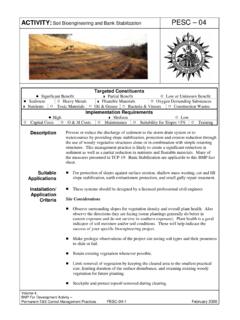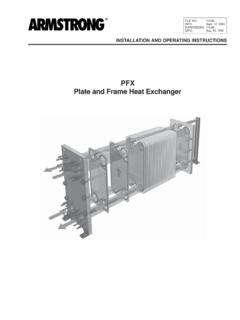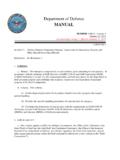Transcription of Nashville.gov - Stormwater - Management Manual - Vol 4 …
1 ACTIVITY: Silt FenceTCP 13 Volume 4: Stormwater Best Management Practices Temp. Construction Management PracticesTCP-13-1 February 2000 Targeted Constituents! Significant Benefit Partial Benefit" Low or Unknown Benefit! Sediment" Heavy Metals" Floatable Materials" Oxygen Demanding Substances" Nutrients" Toxic Materials" Oil & Grease" Bacteria & Viruses" Construction WastesImplementation Requirements! High Medium" Low Capital Costs O & M Costs Maintenance" Suitability for Slopes >5% TrainingDescriptionA silt fence is made of a filter fabric which has been entrenched, attached to supportingpoles, and sometimes backed by a wire fence for support. The silt fence detainssediment-laden water, promoting sedimentation behind the silt fence is a temporary sediment barrier consisting of filter fabric stretched acrossand attached to supporting posts, entrenched, and depending upon the strength of thefabric used, supported with wire fence. Silt fences trap sediment in two ways: (1) byintercepting and detaining small amounts of sediment from disturbed areas duringconstruction operations in order to promote sedimentation behind the fence; and (2) bydecreasing the velocity of low flows (up to cfs ( x 10-2 m3/s)) in swales.
2 Insimpler terms, a silt fence does not filter the water it slows it down enough for thesediment to settle out of the runoff water. This Management practice is likely to createa significant reduction in fences, while much more effective than straw bales and brush barriers, are not aseffective as sand bag barriers or rock filters (especially continuous berms). Thedifference in effectiveness is due to the durability and maintenance # Along the downstream perimeter of the phase construction.# Below the toe of a cleared slope.# Upstream of sediment traps or basins.# Along streams and channels (not across).# Around temporary spoil areas.# Across swales with catchments less than 1 acre ( ha) (per 400-feet ( m) offence) and below other small cleared areas. ACTIVITY: Silt FenceTCP 13 Volume 4: Stormwater Best Management Practices Temp. Construction Management PracticesTCP-13-2 February 2000 Installation/ApplicationCriteria# Silt fences are typically installed with area draining to every 100-feet ( m)of silt fence.
3 They are designed to function under a 10-year storm event and maybe operated for as long as 5 to 8 months. Silt fences are designed to pond waterbehind them, so it is crucial that they are sufficiently anchored and followcontours. Silt fences that are not entrenched and follow contours can result inworsened erosion.# Silt fences may be used for downstream perimeter control, placed upstream of thepoint(s) of discharge of sheet flow from a site. They may also be used as interiorcontrols below disturbed areas where runoff may occur in the form of sheet and rillerosion, and perpendicular to minor swales or ditch lines for up to one acrecontributing drainage areas. Silt fences are generally ineffective in locations wherethe flow is concentrated and are only applicable for sheet or overland flows.# Use principally in areas where sheet flow occurs.# Install along a level contour, so water does not pond more than feet ( m) atany point.# The maximum slope perpendicular to the fence line should be 1:1.
4 # No more than acre ( ha) per 100 ft. ( m), or cfs ( x 10-2 m3/s) ofconcentrated flow should drain to any point along the silt fence.# Turn ends of fence uphill to prevent scour from wash around.# Provide area behind the fence for runoff to pond and sediment to settle ( ( m2) per acre ( ha) draining to the silt fence).# Select filter fabric which retains 85% of the soil, by weight, based on sieveanalysis, but is not finer than an equivalent opening size of 70.# Select standard duty or heavy duty prefabricated silt fence based on criteria shownbelow: Standard Duty Silt Fence-Slope of area draining to fence is 4:1 (H:V) or is generally limited to less than five draining to fence produces low sediment prefabricated standard duty silt Duty Silt Fence-Slope of area draining to fence is 1:1 (H:V) or generally limited to eight months. Longer periods may require draining to fence produces moderate sediment prefabricated heavy-duty silt fence.
5 Heavy duty silt fences typically havethe following physical characteristics: ACTIVITY: Silt FenceTCP 13 Volume 4: Stormwater Best Management Practices Temp. Construction Management PracticesTCP-13-3 February 2000(1) Fence fabric has greater tensile strength than other fabric typesavailable from manufacturer.(2) Fence fabric has a greater permittivity than other fabric types availablefrom manufacturer.(3) Fence fabric may be reinforced with a backing or additional support toincrease fabric strength.(4) Posts may be spaced closer together than other premanufactured siltfence types available from manufacturer.# Most manufactured silt fencing has a colored band that indicates the depth oftrenching required. If the lower colored band is visible then the silt fence is nottrenched deep enough.# Install silt fence along a level contour, with the last 6 ft ( m) of fence turned upslope. Except for the ends, the difference in elevation between the highest andlowest point along the top of the silt fence shall not exceed one-third the fenceheight.
6 # Posts should be spaced a maximum of 6 feet ( m) apart and driven securely intothe ground a minimum of 30 inches ( m).# A trench should be excavated approximately 8 inches ( cm) wide and 12inches ( cm) deep along the line of posts and upslope from the barrier.# When standard strength filter fabric is used, a wire mesh support fence should befastened securely to the upslope side of the posts using heavy-duty wire staples atleast 1 inch ( cm) long, tie wires or hog rings. The wire should extend into thetrench a minimum of 4 inches ( cm).# The standard strength filter fabric should be stapled or wired to the fence, and 40inches (102 cm) of the fabric should extend into the trench. When extra-strengthfilter fabric and closer post spacing are used, the wire mesh support fence may beeliminated and the filter fabric stapled or wired directly to the posts.# Avoid the use of joints. The filter fabric should be purchased in a continuous roll,then cut to the length of the barrier.
7 When joints are necessary, filter cloth shouldbe spliced together only at a support post, with a minimum 6-inch ( )overlap, and both ends securely fastened to the post.# The trench should be backfilled with compacted native material.# Generally, silt fencing should be used in conjunction with erosion source controlsup slope to provide effective # Inspect weekly and after each rainfall.# Repair wherever fence is damaged.# Remove sediment when it reaches 1/3 the height of the fence. ACTIVITY: Silt FenceTCP 13 Volume 4: Stormwater Best Management Practices Temp. Construction Management PracticesTCP-13-4 February 2000# Inspect silt fence when rain is forecast. Perform required maintenance before thestorm event.# Remove silt fence when no longer needed. Fill and compact post holes andanchorage trench, remove sediment accumulation, and grade alignment to blendwith adjacent # Do not place fence on a slope, or across any contour line. This may result in worseerosion than not installing the fence at all.
8 # Do not use in streams, channels, or anywhere flow has concentrated.# Do not use in locations where ponded water may cause flooding.#Limit the length of slope draining to any point along the silt fence to 100 ft. (30 m)or less.#Limit length of any single run of silt fence to 500 ft. (150 m).#Must be placed along a level contour.#Don t use below slopes subject to creep, slumping, or landslides.# Don t use silt fences to divert fences are preferable to straw barriers in many cases. Laboratory work at theVirginia Highway and Transportation Research Council has shown that silt fences cantrap a much higher percentage of suspended sediments than can straw bales. While thefailure rate of silt fences is lower than that of straw barriers, there are many instanceswhere silt fences have been improperly of a filter fabric is based on soil conditions at the construction site (whichaffect the equivalent opening size (EOS) fabric specifications) and characteristics ofthe support fence (which affect the choice of tensile strength).
9 The designer shouldspecify a filter fabric that retains the soil found on the construction site yet will haveopenings large enough to permit drainage and prevent clogging. The following criteriais recommended for selection of the equivalent opening size:1. If 50 percent or less of the soil, by weight, will pass the standard sieve , select the EOS to retain 85 percent of the soil. The EOS should not be finerthan EOS For all other soil types, the EOS should be no larger than the openings in the Sieve No. 70 [ in. ( mm.)] except where direct discharge to astream, lake, or wetland will occur, then the EOS should be no larger thanStandard Sieve No. reduce the chance of clogging, it is preferable to specify a fabric with openings aslarge as allowed by the criteria. No fabric should be specified with an EOS smallerthan Standard Sieve No. 100 [ in. ( mm)]. If 85 percent or more of asoil, by weight, passes through the openings in a No. 200 sieve [ in.]
10 ( )], filter fabric should not be used. Most of the particles in such a soil would not be ACTIVITY: Silt FenceTCP 13 Volume 4: Stormwater Best Management Practices Temp. Construction Management PracticesTCP-13-5 February 2000retained if the EOS was too large, and they would clog the fabric quickly if the EOSwas small enough to capture the fence should be supported by a wire mesh if the fabric selected does not havesufficient strength and bursting strength characteristics for the planned application (asrecommended by the fabric manufacturer). Filter fabric material should containultraviolet ray inhibitors and stabilizers to provide a minimum of six months ofexpected usable construction life at a temperature range of 0 F to 120 Storm Water Best Management Practice Handbooks, CDM for theCalifornia SWQTF, Storm Water Quality Handbooks, CDM for the California Departmentof Transportation, Management Practices and Erosion Control Manual for Construction Sites, FloodControl District of Maricopa County, Arizona, September Action Manual , City of Austin, Texas, of Standards of Erosion and Sediment Control Measures, Association of BayArea Governments, June Guidance Specifying Management Measures for Sources of NonpointPollution in Coastal Waters, Work Group Working Paper, USEPA, April, and Erosion Control Practices, An Introductory of Current Practices(Draft)














